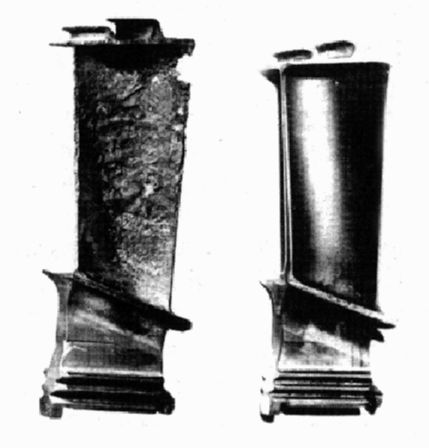
The result of 2500 h low altitude sea flight service on an uncoated and NiAl coated blade turbine blade, from Eskner, 2004.
| Introduction | Bond Coats | TBC | Processes | Resources | |
| [Map] [History] [The Gas Turbine] [Materials] [Degradation] [Coatings] | Back to phase-transformation home page |
The high-pressure turbine of a jet engine provides one of the most severe environment faced by man-made materials. To temperatures approaching the substrated melting point, one must add the considerable stresses caused by rotation at more than 10,000 rpm.
With today's jet engine operating temperatures, thermal barrier coating failure results in melting of the blade. But even without reaching such catastrophic failure, blades suffer from accelerated oxidation and, depending on the environment, hot corrosion. Coatings can considerably enhance the oxidation/hot corrosion resistance of these components, as illustrated below:
 |
The result of 2500 h low altitude sea flight service on an uncoated and NiAl coated blade turbine blade, from Eskner, 2004. |
Oxidation is the reaction between the coating (or in its absence, base
alloy) with the oxidants present in the hot gases.
Hot corrosion occurs from surface reactions with salts deposited from the
vapour phase.
As discussed in the next section, different service conditions result in
different degradation mechanisms being predominant.
In addition of oxidation and hot corrosion, coatings will evolve through
diffusion with the substrate alloy, as they are not in thermodynamic equilibrium
with the latter.
This is of concern, not only because it may modify the
carefully designed mechanical properties of the substrate, but also because loss
of Al to the substrate reduce the oxidation life of the coating.
| conditions of use | 2004 Thomas Sourmail. | Feedback greatly appreciated |